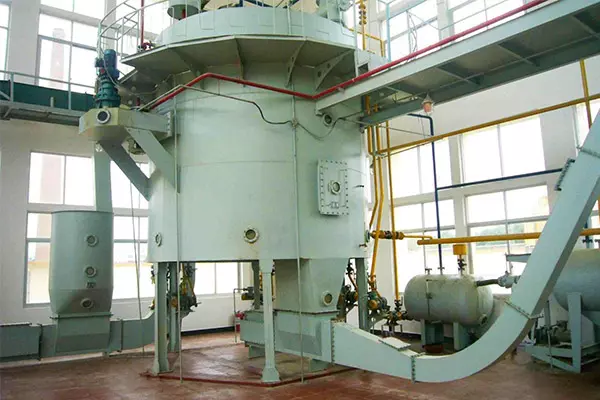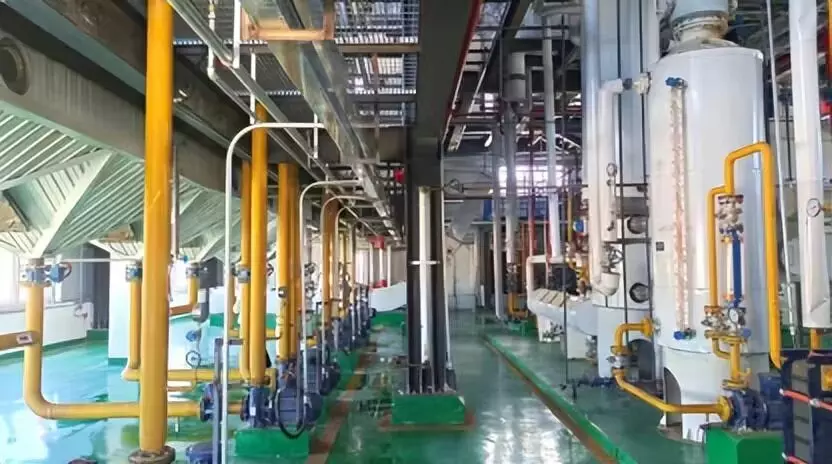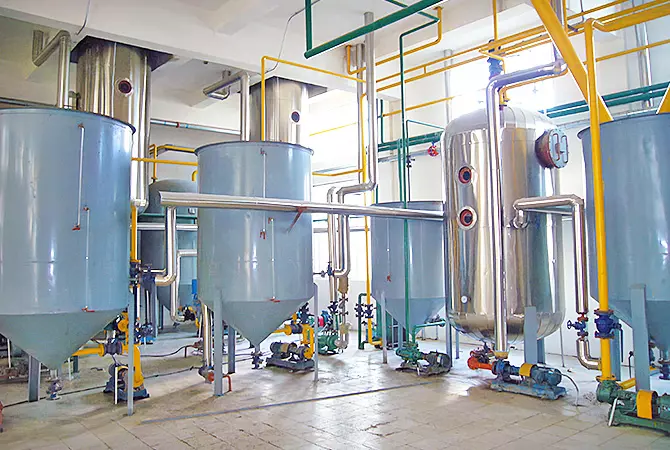
Introduction
Soybean oil is one of the most widely produced vegetable oils globally, and solvent extraction of soybean oil is a common method to extract it. This process involves using a hexane solvent to dissolve the raw material’s oil molecules. Subsequent separation of the solvent from the oil yields the desired soybean oil.
What is solvent extraction of soybean oil?
You start by preparing the soybean seeds, which involves crushing them into small pieces, flaking them into thin materials, and then soaking them in a solvent, usually hexane, to dissolve or extract the oil.
After soaking, evaporate and recover the solvent from the oil, then transfer the oil to storage before refining. The solvent is also recovered from the spent extracted solids, which are then dried and sized for animal feed. (Read more: soybean oil extraction process >>)

Soybean solvent extraction process
Huatai soybean solvent extraction process
Usually, soybeans contain about 17% oil, which is why our clients choose the soybean oil solvent extraction method for processing soybeans when the capacity exceeds 30 tons per day. The soybean oil solvent extraction method includes four main parts:
Soybean solvent extraction
We use N-hexane to react with oil seeds or cake to extract more oil. After this process, you will get two parts: a mixture of solvents and oil called miscella oil, and a mixture of solvents and a meal called a wet meal.
Wet meal DTDC system
DTDC stands for desolventizing, toaster, dryer, and cooler. This system separates the solvents from the wet meal, then sends the dried meal to a meal silo for storage.
Miscella oil treatment
Since miscella oil contains solvents, we separate the solvents from the crude soybean oil through first evaporation, second evaporation, and a stripping tower. Then we condense the oil and pump it into the crude oil tank. You can choose to sell the crude oil to a refinery factory or add a soybean oil refinery plant yourself.
Solvent recovery
Producing one ton of crude soybean oil through this method requires about 4kg of solvents. To ensure cost-effectiveness and environmental protection, we recycle the solvents by condensing and collecting them for reuse.
What affects the solvent extraction of soybean oil?
The leaching process of soybean oil is a core step in producing soybean crude oil. By applying a scientific and reasonable leaching process, you can effectively extract the oil in soybeans. During this stage, you need to accurately control the water content, temperature, time, and other key parameters to ensure efficient extraction of edible oil and maintain quality assurance.
Moisture in soymeal
When leaching soybeans, you must maintain the optimum amount of moisture. The amount of moisture depends on the characteristics of the raw material, the leaching method, and the equipment used.
For example, when using a rotocel extractor to leach soybeans, generally control the moisture of expanded soybeans at 8% to 9%. You need to control the moisture of pre-pressed cake at about 4%. When using a drag chain extractor, the suitable moisture for soybean leaching is generally 9% to 9.5%. And for loop-type extractors, it is 10% to 12%.

Soybean oil extraction process
Leaching temperature
The appropriate leaching temperature by the boiling point of the mixture of soybean oil and solvent, can improve the fluidity of the oil and promote leaching efficiency.
Studies have shown that for every 1°C increase in temperature, the extraction rate of fats and oils can increase by about 0.5%. However, too high a temperature, the oils are susceptible to oxidation, which reduces the quality of the product.
How much oil is extracted from 1 kg soybean?
Soybeans contain 18-20% fat content. Through expeller pressing, you can extract around 12-13% oil, requiring 7-8 kg of soybeans for a liter of oil. By also performing solvent extraction on the oil cake, you can obtain 1 liter of oil from around 5.5 kg of soybeans. (Read more: how is soybean oil made >>)

How much oil is extracted from 1 kg soybean
Can soybean oil be extracted without solvents like hexane?
Although mechanical extraction leaves between 5 and 15% of the oil in the seed cake, making solvent extraction the standard for oil production, it is possible to extract soybean oil without solvents like hexane.
However, this method is less efficient unless the seed cake is sold for animal feed at a higher value. Supercritical Fluid Extraction (SFE) competes with hexane solvent extraction due to its green chemistry aspects and higher effectiveness, despite the increased cost.
Huatai advanced soybean oil extraction machines
Huatai Oil Machinery offers three extractor options to address cost concerns and meet your processing needs: rotocel extractor, loop extractor, and drag chain extractor. These options provide efficient solutions tailored to your production volume and operational efficiency.

Soybean oil extraction machines
Conclusion
Huatai Oil Machinery has built soybean oil solvent extraction plants in various regions and countries. Feedback from our clients in Africa indicates that using the soybean oil solvent extraction method significantly boosts profits compared to single pressing methods. If you are interested in the soybean oil solvent extraction method, please contact us for more details.
Get your best price
- Engineer quick quote
- The overall delivery speed is fast
- Financial choice
- Low installation costs and cost savings
30 years+ of oil mill plant R&D
More than 56 innovative technologies
